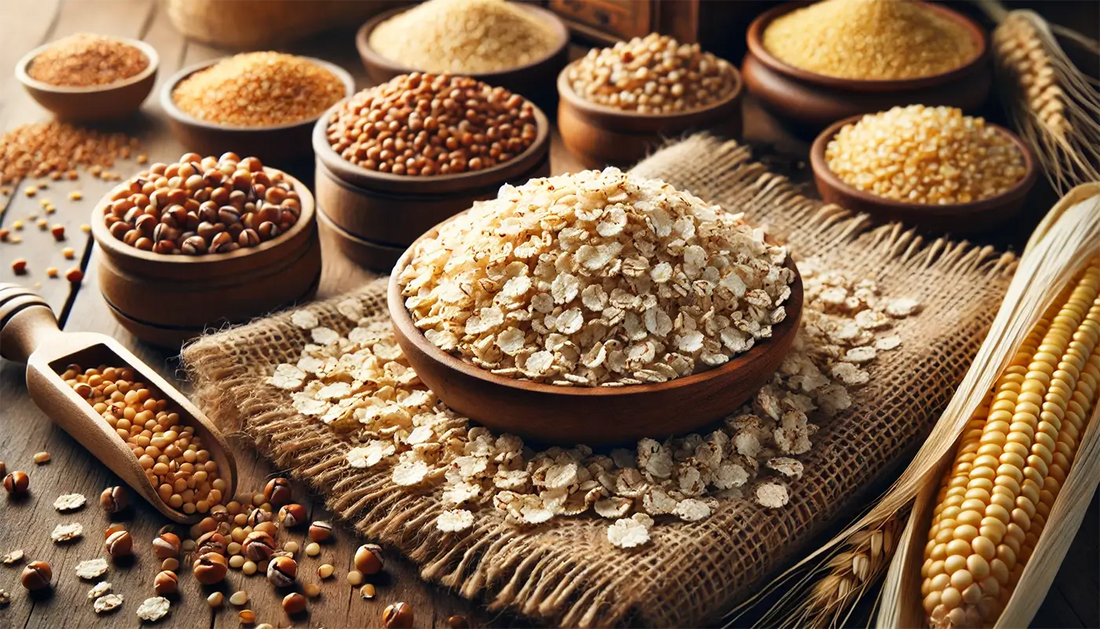
Millet flakes or grains: Comparing health benefits, uses, and nutrition
Millets have gained popularity in recent years, and it is easy to see why. They are nutritious, gluten-free, and versatile, making them a great addition to anyone's diet. But when it comes to millet flakes or millet grains, which one should you choose? In this article, we will focus on the benefits of millet flakes and why they might be the better choice for your needs. Millet flakes vs grains: Which is the better choice?
What are millet flakes?
Millet flakes are made from millet grains through a process that involves steaming and rolling the grains into thin, flat flakes. They are similar in appearance to rolled oats and offer a convenient way to add millets to your diet. Millet flakes have a mild flavour and a soft texture, which makes them ideal for quick breakfasts and snacks.
Millet flakes are often used in porridge, muesli, or as an ingredient in baked goods. They are a good source of nutrients like iron, magnesium, and phosphorus, and they are also gluten-free. Because they are processed from whole grains, millet flakes retain most of the nutritional benefits of millet grains. The millet flakes vs grains debate continues...
Nutritional benefits of millet flakes
Millet flakes provide many nutritional benefits. They are a good source of essential nutrients, including iron, magnesium, and B vitamins. Millet flakes are easy to digest and are perfect for a quick, nutritious meal. They also provide essential amino acids that support muscle repair and growth.
While millet grains may contain slightly more fibre, millet flakes are still packed with nutrition. Their processing retains most of the nutrients, making them a great option for maintaining overall health. Millet flakes are also gluten-free, making them suitable for people with gluten intolerance or celiac disease.
Cooking with millet flakes
Millet flakes are incredibly easy and quick to prepare. They can be cooked in just 5 minutes by adding hot water or milk. This makes them an excellent option for busy mornings when you need a nutritious breakfast without much effort. Millet flakes can be used in a variety of ways, such as in porridge, smoothies, or even baked goods like cookies and muffins.
The convenience of millet flakes is one of their biggest advantages. Unlike millet grains, which require more preparation and cooking time, millet flakes can be ready in minutes. This makes them an ideal choice for anyone who needs a healthy meal on the go.
Weight loss benefits of millet flakes
Millet flakes are a great choice for weight management, especially if you are looking for a lighter meal or snack. They are low in calories and provide a good amount of protein, which can help support muscle growth and repair. Their quick digestibility makes them a good option for anyone looking to manage their weight without feeling overly full.
Although millet flakes contain slightly less fibre than millet grains, they are still effective in keeping you satisfied. They provide slow-releasing carbohydrates, which help maintain energy levels and reduce cravings throughout the day. If you are looking for a convenient, low-calorie option to include in your weight management plan, millet flakes are an excellent choice.
Digestive health benefits of millet flakes
Millet flakes are easy on the digestive system, making them a suitable option for people with sensitive stomachs or digestive issues. While they may have slightly less fibre than millet grains, they still provide enough to support healthy digestion. The soft texture of millet flakes is gentle on the digestive tract, which makes them ideal for children, older adults, or anyone recovering from digestive discomfort.
Millet flakes are also known for their prebiotic properties, which help nourish beneficial gut bacteria. A healthy gut microbiome plays an essential role in overall digestive health, and adding millet flakes to your diet can help promote a balanced gut.
Versatility in cooking with millet flakes
Millet flakes are perfect for quick and easy meals. They are versatile and can be used in a variety of dishes, from breakfast to snacks and even baked goods. Their soft texture makes them appealing to both children and adults, and they are a great way to add nutrition to your diet without much effort.
Because millet flakes are easy to incorporate into different recipes, they are a convenient way to boost the nutritional content of your meals. You can mix them into yogurt, add them to pancake batter, or use them as a topping for salads. Their versatility makes them a must-have ingredient in any healthy kitchen.
Why millet flakes are a better choice
Millet flakes offer a range of benefits that make them an excellent choice for many people.
- Convenience: Millet flakes are quick and easy to prepare, making them ideal for busy individuals who want a nutritious meal without spending too much time in the kitchen.
- Digestibility: Millet flakes are easy on the digestive system, making them suitable for those with digestive issues or sensitive stomachs.
- Versatility: Millet flakes can be used in a variety of dishes, from breakfast to snacks and even baked goods, making them a versatile addition to your pantry.
- Nutrient-dense: Despite the minimal processing, millet flakes retain most of the nutrients found in millet grains, providing essential vitamins and minerals to support overall health.
Millet flakes vs grains: Which is the better choice?
While both millet flakes and millet grains offer numerous health benefits, millet flakes have an edge when it comes to convenience, versatility, and ease of digestion. Millet flakes are perfect for those who need a quick, nutritious meal that can be prepared in minutes. They are also gentle on the digestive system and can be used in a wide range of recipes.
If you are looking for a healthy, gluten-free option that fits into a busy lifestyle, millet flakes are the better choice. They provide the nutrition you need without the hassle of long cooking times. Incorporate millet flakes into your diet and enjoy the benefits of this versatile and nutritious ingredient.
Image Courtesy: ACCENTERRA
Did you find this blog post helpful? Got ideas or questions? Join the conversation below! Your insights could help others too, so don’t hesitate to share!
Please note that all comments will be moderated before being published.
